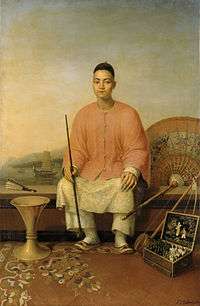Magua (clothing)

The magua (simplified Chinese: 马褂; traditional Chinese: 馬褂 Manchu: ᠣᠯᠪᠣ olbo) was a style of jacket worn by males during the Chinese Qing dynasty (1644–1911), known to the Hakka people as a dajinshan (大襟衫), it was designed to be worn together with and over the manshi changshan (滿式長衫). The garment was available in a number of styles: singlet (单; shan), clip (夹; jia), leather (皮; pi), cotton yarn (纱; sha) quilted (棉; mian) and others. It was worn by Manchu people throughout China from the reign of the Qing Shunzhi Emperor (r. 1643-1661) until the time of the Kangxi Emperor, (r. 1661-1722),[1] whence it became popular throughout Qing China.
Rendered literally in English as "riding jacket", the magua had its origins as a simple tabard like item of clothing intended to protect the changsan during riding and normal everyday activities. However, with time the magua itself became more elaborate, becoming for officials part of their uniform of office; one variation of the magua, the imperial yellow jacket, becoming an indication of Imperial approval of an individual.
Later fashions
The magua is considered the predecessor of the basalm jacket (鳳仙裝, fèngxiān zhuāng)[2][3] and the tangzhuang.
Burmese taikpon
As a garment of Chinese origin[4], the taikpon eingyi (တိုက်ပုံအင်္ကျီ), a traditional jacket for Burmese men, is a descendant of the magua. This costume was popularized during the colonial era.
See also
References
- ↑ 袁傑英紡沈蓁. 中國旗袍. 中國紡織出版社. 2000. ISBN 7506417073. (in Chinese)
- ↑ Nickerson, Peter (2005), "Attacking the Fortress: Prolegomenon to the Study of Ritual Efficacy in Vernacular Daoism", Scriptures, Schools, and Forms of Practice in Daoism: A Berlin Symposium, Asien- und Afrika-Studien der Humboldt-Universität zu Berlin, No. 20, Wiesbaden: Harrassowitz Verlag, pp. 117–185 .
- ↑ Cheng Hong-sheng (2008), "The Qipao, the Western Dress, and the Taiwanese Shan: Images from 100 Years of Taiwanese Clothing", in Jiang Yajoo, Inter-Asia Cultural Studies, Vol. 9, No. 2, Abingdon: Routledge, pp. 300–323 .
- ↑ Kyaw Win, U; Turnell, Sean (2016). My Conscience: An Exile's Memoir of Burma. Wipf & Stock Publishers. p. 5. ISBN 978-1-4982-8271-0. Retrieved 2018-03-01.
The taik pon eingyi [jacket] is of Chinese origin.
| Chinese Wikisource has original text related to this article: |